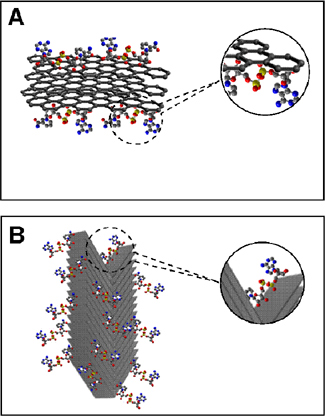Nanoscience for the improvement of biosensors

In recent years, with the great progress made in nanoscience and nanotechnology, interest is increasing in exploring the unique properties and potential technological applications of various nanostructures. Many nanomaterials have been devoted to decreasing the high overpotential for ß-Nicotinamide adenine dinucleotide (NADH, a cofactor in NAD+/NADH-dependent dehydrogenases) oxidation, minimizing surface fouling, and improving electron-transfer kinetics. Depending on the size, shape, and internal structure, nanoparticles frequently display unique physical and chemical properties.
In the present research we have modified electrodes with electrically conductive carbon materials in order to study the oxidation of NADH,with interest for the development of amperometric biosensors. The use of carbon materials (i.e. CNT: carbon nanotubes, CNF: carbon nanofibers and CMP: carbon microparticles) as electrode modifiers have advantages in terms of the new electrocatalytic properties they give to the sensors being at the same time stable and having reasonable cost.
In the case of CNTs and CNFs there are significant structural differences. CNF consist of graphitic layers that stack either at an angle, perpendicular or parallel to the tube axis and represent a nanometer-size diameter and no hollow core, but with many edge sites on the outer wall. CNTs represent two single-walled and multi-walled structures. Single-wall CNTs (SWCNTs) comprise of a cylindrical graphite sheet of nanoscale diameter capped by hemispherical ends. The multi-wall CNTs (MWCNTs) comprise several to tens of incommensurate concentric cylinders of these graphitic shells with a layer spacing of 0.3-0.4 nm. Due to the unique characteristics of CNF and CNT there is a wide range for their applications. The thermal and chemical stability, high surface area, low ohmic resistance, and the surface properties are the unique qualities that are exploited when CNFs and CNTs are used as catalytic support materials.
We have studied the properties of CNT, CNF and CMP used as doping materials for electrochemical sensors. The efficiency of these materials (either before or after acidic treatments) while being used as electrocatalysts in electrochemical sensors is investigated for NADH detection using cyclic voltammetry (CV). In this work, chemically treated and untreated carbon materials were used as modifiers of glassy carbon and gold electrode surfaces. The sensitivity of the sensors (glassy carbon - GC- and gold -Au) modified with both treated and untreated materials have been deeply studied. The response efficiencies of the GC and Au electrodes modified with CNF and CMP, using dimethylformamide (DMF) as dispersing agent are significantly different due to the peculiar physical and chemical characteristics of each doping material. Several differences between the electrocatalytic activities of CMs modified electrodes upon NADH oxidation have been observed. The CNF film promotes better the electron transfer of NADH minimizing the oxidation potential at +0.352 V. Moreover higher currents for the NADH oxidation peak have been observed for these electrodes. The shown differences in the electrochemical reactivities of CNF and CMP modified electrodes should be with interest for future applications in biosensors. This work is still in process at our laboratories.
References
"Carbon nanofiber vs. carbon microparticles as modifiers of glassy carbon and gold electrodes applied in electrochemical sensing of NADH". Briza Pérez, Manel del Valle, Salvador Alegret & Arben Merkoçi. TALANTA 74 (2007) 398-404.

